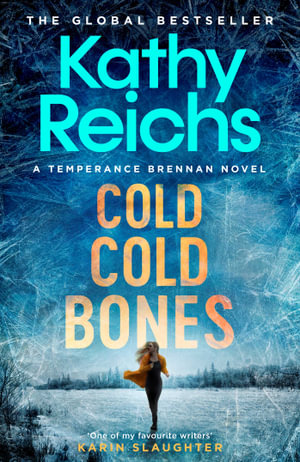Twenty-five years after KATHY REICHS’ first novel became a runaway bestseller she is still captivating readers with her chilling stories.
On the lead-up to the Australian launch of her latest book, Cold, Cold Bones, she tells KAREN WILLIAMS all about ‘dem bones’, and how much you can learn from a skeleton.
I am seriously overawed by Kathy Reichs’ enduring love of and dedication to the study of bones. She has had a lifelong career in forensic anthropology, which has not only meant that she’s been able to help solve myriad of horrific crimes, identifying hundreds of victims of major disasters, but it has also seen her undertake a number of challenging roles including being a witness in genocide trials in places like Rwanda.
Her work has provided rich pickings for scores of ideas, characters and plots for more than 30 internationally bestselling crime novels as well as for Bones, one of Fox’s longest running TV crime series.
Kathy Reichs has more than earned her title of ‘master of the forensic crime genre’ which David Baldacci applies to her. Fans of her writing won’t be disappointed in her latest book featuring the forensic anthropologist, Tempe Brennan. Cold, Cold Bones is the 21st book in the ‘Temperance Brennan’ series and draws on the earlier books that are based on real life cases.
The story begins when a package is left on Tempe’s doorstep. Inside is an eyeball and when it’s examined closely, Tempe and her daughter, Katy, find minute GPS coordinates etched onto it. This leads them to visit a Benedictine monastery and to another gruesome discovery …
Then several parts of bodies start appearing in different locations. A head. A torso. There is an apparent suicide. Initially there doesn’t seem to be any connection but Tempe can’t shake the feeling that they’ve overlooked some important clues. She has a hunch about an old case but her instincts are dismissed. As the tension builds along with numerous spine-chilling incidents,
Tempe begins to wonder if someone is mimicking crime cases that she has worked on. Tempe Brennan is a sassy, intelligent woman who is a forensic anthropologist. It is no surprise that she shares some of Kathy’s characteristics.
‘She is very competitive,’ Kathy says. ‘She likes to win and to solve problems. However, she takes far many more risks than I would ever contemplate in real life. That is the beauty of writing fiction.’
I was surprised to learn that Kathy thought writing requires equal dedication and hard work to that of her professional job as a forensic anthropologist.
‘For instance,’ she says, ‘It gets harder in this series of 21 books to ensure that Tempe is reintroduced into the story in an engaging or interesting way.

Val McDermid once wrote about the three qualities – curiosity, dedication and a love for humanity – that are notable qualities to be a successful anthropologist. But an equally important factor plays out in this profession Kathy tells me.
‘You also have to have a high tolerance for dealing with decomposing bones, their smells, and an autopsy room,’ says Kathy. ‘This was always the ultimate test for students to see if they could tolerate the smell.’
She has never been squeamish.
‘Even as a child, I was always outside, exploring nature, digging in the dirt. I was known to do autopsies on dead animals that I brought home,’ she adds.
Kathy wasn’t initially drawn to forensic anthropology. Her studies and interests lay in digging up and studying ancient bones, a science known as bioarchaeology.
However, shortly after doing her doctorate she became hooked when she discovered it not only included the study of human beings and their behaviour but it encompassed the physical science.
‘This meant you could analyse, measure and literally put your findings under the microscope. That had enormous appeal for me.’
In the TED Talk event, ‘Changing the Narrative’, Kathy talked about a significant point early in her career while working in a laboratory. Two police detectives approached her about a child who had gone missing. Some bones had been found but they couldn’t be identified conclusively. Could she help? While it was a particularly sad case, being able to resolve it and, ultimately, see justice done was enormously satisfying for her. Reichs’ work then revolved around working with many different teams to identify crime victims and perpetrators. Eventually this saw her dealing with some of the most disturbing and inhumane crimes including the Genocide trials conducted by the United Nations in Rwanda and Guatemala.
As she had witnessed the outcomes of such horrendous crimes as these, I wondered whether Kathy found the act of writing therapeutic in any way,
‘Cathartic, yes,’ she says, ‘in lots of ways. But no, not therapeutic. Somehow you learn to divorce your emotions in order to do a professional job. I remember one particular time with Clyde Snow sitting at the site of an open mass grave, and him saying to me any “crying must be done at home”.’
Kathy tells me the hardest case she worked on was ‘also the most disturbing case, both physically and mentally, was 9/11. The work was harrowing. We came in on the second wave, working 13 hours a day and even though we were given a lot of psychological support, it was incredibly difficult.’
I wondered if she believed that people can be born evil.
‘There are evil people,’ she says. ‘Some are created by their environment or upbringing and some are just born that way.’
Although it is commonly acknowledged that to be a successful writer you have to write about what you know, Kathy reminds me that hard work and serendipity were at play when she started out.
After becoming a university professor Kathy suddenly had some spare time and decided she would try her hand at writing. Whether it was just for the novelty of it or not, she threw herself into it, getting up every cold wintry morning at 6 am to write for two hours.
‘I’d never written anything creative but I had a strong story idea that drew on a serial case that I’d just finished working on. It took me two years to write the book but as soon as I finished it, I printed it out and sent it to Scribner where it ended up on the desk of a junior editor. It was a time when there was a growing interest in forensic crime as a genre, which may have been stimulated by the daily media coverage of the O J Simpson trial.’
Deja Dead was published in 1997. In a very short space of time, it was a New York Times bestseller, also winning the prestigious Arthur Ellis award for the best first crime novel.
Kathy says she was astounded by its success and despite her busy schedule continued writing, an occupation which she still loves.
‘Each book takes about a year to write and when I’m not writing I do miss it.’
That’s lucky for us.






